Nurseries and orchards often use grafts to propagate plants. Grafting itself is a simple operation which involves holding two parts of different plants together, generally the root and stem, so as to make them grow into a new plant combining the best characteristics of both plants, the one chosen for its root system, and the other for its stem or trunk and branches, leaves, flowers and/or fruit. The grafted plant combines a "stock" and "scion", the first going to form the root system of the new plant and the second the foliage. The "scion", also known simply as the "graft", can be anything from a single bud, often called an "eye", to a one-year- old branchlet, sometimes known as a cion.
Why fruit trees. For simplicity's sake, we'll limit ourselves to grafts for fruit trees. The same considerations, however, hold true for ornamental trees. Reproduction by seed is rarely considered worthwhile by fruit· farmers because plants which have grown from seed generally exhibit "wild" characteristics, or are in some way inferior to their mother plants. To maintain the characteristics of a particular variety, or "cultigen" in jargon, it is necessary to propagate by cutting, layering or grafting (known as agamic propagation). This allows you to be certain the characteristics of the cultigen you want to breed will be maintained, making it easy to obtain a large number of identical plants (clones) from a single prized plant.
Important: the stock. When grafting fruit trees you have the possibi lity of choosing the stock with the most suitable root system for a particular type of soil, or which is most resistant to certain parasites. Your choice of stock is important because it influences the strength of the plant, and can also play a fundamental role in determining when it will come into fruit, or in improving the colour and other organoleptic qualities of the fruit. Some fruit trees, such as the actinidia (kiwi fruit), fig, hazel, olive, and lemon, for example, can also be propagated by cutting or layering. The same is not the case for the cherry, apple, pear or plum (they do not take root easily) and many other fruit trees, which must, therefore, be propagated by grafting.
The advantages By grafting, then, you can repeat the characteristics of the variety, and if we take a scion or bud from the same "mother" plant, we will obtain plants with exactly the same characteristics, all identical to one another. That is something very important, since modern fruit farming not only has to grow carefully selected varieties, but also needs to satisfy the demands of a market that wants fruit of a uniform size and quality. Even amateurs frequently use the technique of grafting, above a11 to propagate old varieties which have been handed down across the generations but are difficult to obtain from nurseries.
The choice of stock is fundamental in determining the size of the plant. The famous East Malling Clones have recently been introduced into Italy, for example, where they are highly valued as dwarf stocks, suited to obtaining plants that will not grow too high and be able to bear fruit within as little as two years from grafting.
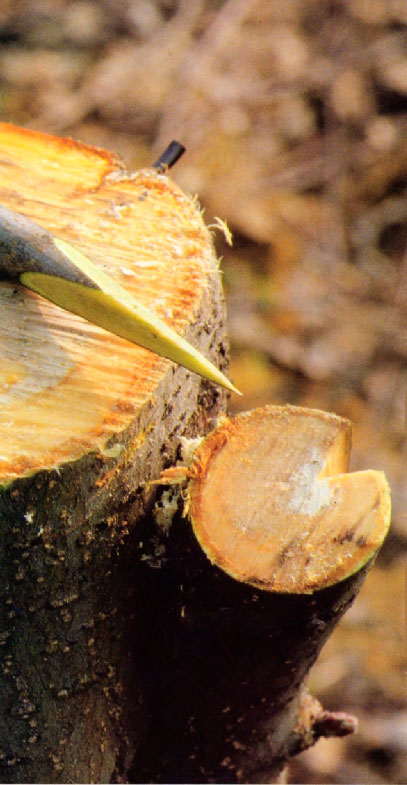 |
An apple plant from which the old stem has been removed A branch has also been cut ready for grafting, in this case a notch grafting. The scion, seen resting on the old cut trunk, must have two buds and has been shaped to fit perfectly into the notch prepared for it. |
Good results.. The graft will be successful when there is a good level of affinity between the two parts, namely the stock and scion, such that the tissues in contact with one another grow healthily together. As a general rule, grafting is only possible for plants of the same species and, in some cases, between related species, (for example between different species of the same type of fruit, or at least belonging to the same families). There is, however, no lack of exceptions, such that one can graft apricot onto cherry plum, cherry onto rock cherry, Japanese medlar onto quince or hawthorn, and mandarin onto Poncirus tn/oliata.
The affinity of grafts can, however, vary greatly even within the same species. The "Kaiser" pear, for instance, cannot be grafted onto quince due to a form of incompatibility between the two plants. One can, however, get round the problem and produce small Kaiser pears by "regrafting", that is say by using a variety of pear with an affinity for both the Kaiser pear and quince as an intermediate graft. Wild plants are generally chosen as stocks, whether of spontaneous or cultivated origin, since they are more hardy and vigorous; in jargon one says these plants are grafted "onto the seedling".
When to graft It is important to graft at the right time to obtain a graft that grows together healthily and heals perfectly. Exactly when depends on the climate, species and type of graft. Generally speaking, however, two periods are most suitable: early Spring - from late March to April, when Spring growth is at its strongest; or from August to September, between the end of Summer and the first Autumn rains, when the plants are "in sap": the period when the sap circulating in the plants is at its highest. If the graft is a bud grafting, the buds can grow immediately (a "budding grafting"), as happens with Spring grafts, or only in the following year (a "dormant bud grafting"), the case with Summer grafts. The choice of one or the other of these methods depends on the size of the stock and scion, the age of the plant, and when they are most likely to heal up quickly. On the whole, however, the choice is generally dictated by local custom and the ability of the grafter.
"Taking". It is crucially important for the buds or scions to be grafted in the right place following the techniques shown in the illustrations. For the two parts to "take" perfectly, making for a successful graft, the generative tissues of stock and scion alike must come into contact with one another, enabling a full flow of sap between them in the area beneath the bark where this is most intense. Finally, it is extremely important to make the cuts and incisions using scissors, knives and other specialist grafting tools that are both well sharpened and have exactly the right shape for the job.
Scion grafting Scion grafting involves fitting one or more pieces of branch with several buds into the stock. This type of graft can be carried out on young and adult plants alike, in the greenhouse or directly on plants out in the field, on thin or thick branches and even on old stumps. For the graft to be successful, it is essential for the plant to be "in sap" and the buds to be dormant, as a result of which they should be cut in advance, generally in the winter, and kept in a cool place in sand or even refrigerated at 2-3°.
Scion grafting can be carried out between February and April, exactly when depending on the climate and species.
The scions should be bound tightly with raffia, with special grafting tapes or other binding materials, and then every cut surface must be covered with grafting wax to prevent the graft from drying out.
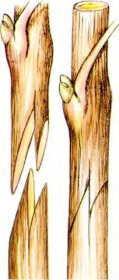 |
Twin cleft whip grafting or tongue grafting For this type of graft to be successful, the branchlets which are joined together must be of the same diameter, young and well lignified (they must be a year old). Vines, actinidia (kiwi fruit) and other fruit trees graft easily in this way. The tongues should be ·"-._,; lodge securely in one another. Binding materials are not used. |
|
Bud grafting The best periods for bud grafting are April-May and July-August. The technique is used for many fruit trees, and is also suitable for roses and other ornamental plants. Only one bud is grafted onto each wild stock. vent |
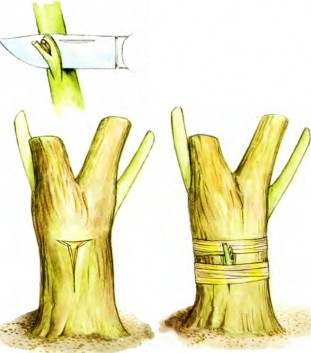 |
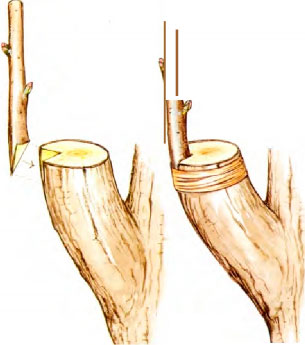 |
Notch grafing The drawing shows a notch grafting, suitable above all for apple, pear, plum, cherry and quince trees. The graft should be made in March or early April, and is most successful on trees that are two to three years old. It needs binding. |
|
Cleft grafting for fruit trees Used above all for apple, pear, walnut, Japanese persimmon and fig trees, and |
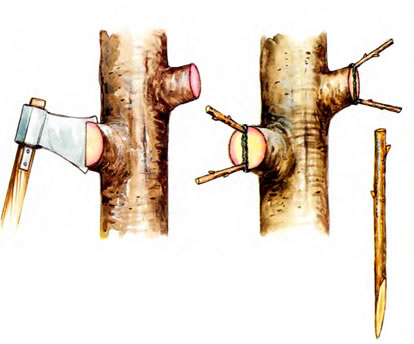 |
Notch grafting. This type of graft is suitable for apple, pear, plum, cherry and quince trees. The graft should be made in March or early April, and is most successful on plants that are 2 to 3 years old. The branch to be grafted is first cut horizontally and then two vertical cuts are made from the side to cut out a triangular piece of wood about 3 cm deep and approximately I/3rd of the diameter of the branch. The scion, which is taken in advance, must have two buds and should be cut to form a triangular shape that fits perfectly into the cut-out in the stock. It is important, as usual, for the bark of the scion to line up exactly with the bark of the stock. If the branch is young, one only uses a single scion, if it is quite thick, one can graft 2 or 3 scions.
Cleft grafting This type of graft is recommended for apple, pear, walnut, Japanese persimmon and fig trees, and any other fruit trees that for one reason or another can't accept bud grafts or be grafted in any other way. Cleft grafts are best made in Spring or September, and can even be done on large branches or trunks. After having cut the branch or trunk horizontally, use a suitable grafting knife for cleaving to split the branch vertically down the middle to a depth of about 3-4 cm., then use the tip of the tool to hold the cleft open while positioning the scion, or scions if it is a large branch, correctly. The scions should be prepared in advance, cut to form a wedge, and fitted in the cleft so that the barks line up exactly.
Twin cleft whip grafting. Vines, actinidia (kiwi fruit) and other fruit trees graft easily in this way (also known as a "tongue grafting"). For this type of graft to be successful, the branchlets that are joined together should be of the same diameter, young and well lignified. In other words they must be about a year old. The grafts should be made between February and April, and don't generally need either binding or grafting wax. The branchlets of both the stock and scion are cut obliquely in the same way, taking care that the length of the cut is equal to about one and a half times the diameter of the scion. One then makes a matching cut in both branchlets so as to produce a raised tongue in each branchlet that can be lodged in the corresponding cut-out in the other, holding the two more firmly together; (an important operation since no bindings are used).
Bud grafting. Many fruit trees graft easily using a "bud graft", as do roses and other ornamental plants. In each case one grafts a single bud onto each wild plant. Bud grafts are generally made on young greenhouse plants a year or two old, with the graft made at the base of the plant, just above ground level, or "at the foot" of the plant. Two periods in the year are best for bud grafting: July-August and April-May. In the first case, the graft heals up almost immediately, but the grafted bud only starts to grow the following Spring. This sort of graft is consequently known as a "dormant bud grafting". In the second case, on the other hand, the scion comes into bud immediately after the tissues have healed up, this type therefore being known as a "budding grafting". The physical technique is the same for both types of bud graft, with the exception that those done towards the end of the Summer use buds removed from branchlets cut during the Winter months and which are thus still dormant. The branchlet is cut slightly above the chosen bud, removing it together with a small portion of surrounding wood. The leafy part is removed for dormant bud cuttings, although it is best to leave part of the leafstalk, which also makes handling easier. Two cuts are made in a "T" shape on the stock, the first being a vertical one of about 3 cm., and the second a horizontal one about 1 cm. long. These cuts should not go deeper than the bark. Because the plant is "in sap" the two edges can be lifted easily to place the bud portion beneath and between them. When performing this operation you must take every care to avoid damaging the plant tissues. This is best done by using one of the special spatulas fitted to some knives, or by using the tip of the knife itself, turning the knife round and using the side opposite the blade, which has the right shape. Once this has been done, simply close the flaps in their original position and bind them well with raffia or special elastic plastic tape. When the buds have developed, the wild stalk is cut off and any buds which have grown elsewher on the plant are removed.
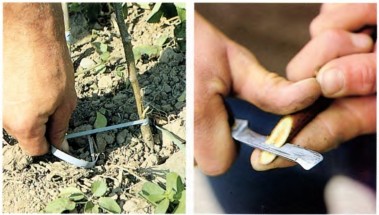 |
Above left: A bud grafting on an apple plant; shown in the process of being bound. Above right: A twin-cleft whip grafting on a vine, at the stage when the second cleft is being made. It is very important to use the right tools, which should always be well sharpened. |
|
Left: Positioning the scion in the stock of a cleft grafting. Grafting maintains all the characteristics of a given variety of plant. Amateurs use this technique to propagate old varieties which have been handed down across the generations and are difficult to obtain from nurseries. |
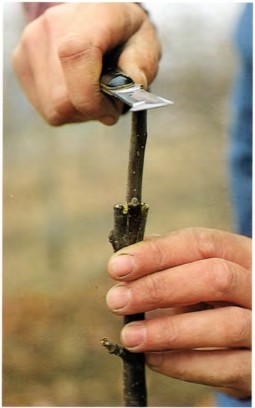 |
Stocks for fruit trees
| Species | Stock |
| Actinidia | "wild" |
| Citrus | bitter orange and Poncirus trz/ollata |
| Apricot | cherry plum |
| Neapolitan medlar | "wild"and hawthorn |
| Carob | "wild" |
| Chestnut | "wild" and Japanese chestnut |
| Cherry | "wild" and rock cherry |
| Quince | "wild" |
| Persimmon | "wild" and Diospyros lotus |
| Persimmon | "wild" |
| Almond | "wild", plum and peach |
| Apple | "wild" and " East Malling" hybrids |
| Pomegranate | "wild" |
| Japanese medlar | "wild" and hawthorn |
| European medlar | "wild", quince and hawthorn |
| Walnut | "wild" and Juglans nigra |
| Pear | "wild" and quince |
| Peach | "wild" and almond |
| Pistachio | "wild" and lentisk |
| Sorb (Service tree) | "wild" (White Beam) and hawthor |
| Plum | cherry plum |
| Vine | American hybrid vines |
The specialists
That great unwritten book which is and has always been there for everyone to read, one day happened to open at the page on grafting, and someone stopped to study it. Nature showed them a clear diagram, using a real live tree, of two branches which had grown together. Closer examination made it possible to unravel the history of events: the wind had previously worn away the bark of two neighbouring branches which, coming into contact with one another, then grew together. That curious ancestor of ours, who observed the facts and by intuition discovered how they had come about, then wanted to make use of his discovery, joining the branch of a cultivated plant onto a wilder plant. Which is how the practice of grafting came about, so that today we know all the details of how, when and why to carry it out. Lets begin with why. Luciano Cretti' s article above explains the basic techniques of grafting in detail.
Before going on to the tools you will need, I'd like to begin with a general introduction. Reproduction by seed does not, in the case of most fruit trees cultivated, result in trees showing exactly the same characteristics as the mother tree. This is both because of the manner in which we have arrived at many of the varieties cultivated (hybridization, bud mutation, chimaera), and because they are often cross pollinated, that is to say fertilised by pollen from other varieties. Varietal identity is obtained by agamic multiplication, effected by cutting, layering and above all grafting.
In other words, for instance, we wouldn't be able to obtain an example of the highly prized Redhaven peach tree by planting the seed of one of these magnificent peaches, but are able to do so by cutting a scion from one of the branches of this variety and grafting it onto a wild peach, plum or almond plant. The graft then, is a union between two varieties of plant with an affinity. If there is no affinity then they will not grow together, and if it is low, the plant will have problems growing, easily forming a highly visible scar callus. Nor is that enough. For the graft to be successful, it is also necessary for the generative tissues (beneath the bark) of stock and scion to be in contact with one another, and for the branch to be kept in the same position and not turned upside down.
Every type of graft has its own season: approach grafting (the imitation of what happens spontaneously in nature) throughout the Winter, scion grafting (cleft, notch, crown grafting ere) generally towards the end of Winter, budding grafts in Spring and dormant bud grafts in August.
What you need.
Whatever type of graft you intend to carry out, you will need the right tools, binding material, and in some cases, grafting wax.
|
|
Knives. For removing buds, shaping scions and cutting the bark of the stocks in bud grafting. They generally feature a bone tongue or spatula for raising and opening out the bark. Those with a hooked shape also serve to give a good finish to cut edges. (Make sure you also buy a sharpening stone for your knives). |
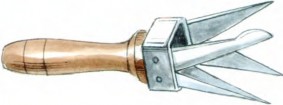 Four-bladed knife for bud grafting. |
Four-bladed knife. For removing ring-shaped strips of bark with a bud. Used for bud grafting. |
 Grafting knife for cleaving |
Grafting knife for cleaving. For making the vertical slit in cleft grafts and for opening the cut. |
|
|
Binding materials. To hold stock and scion in lasting contact, one can use raffia (fibres obtained from the leaf of a palm) or synthetic binding materials which change over time so that it isn't necessary to remove them manually. Many farmers use osiers or insulating tape. |
|
|
|
|
|
Grafting wax. To prevent moisture loss and to protect the cut tissue against air and rainwater. Farmers often use barrel mastic and sometimes prepare the following grafting wax themselves ( to be applied cold): melt 500 g. of boat tar and 500 g. of rosin together on a slow flame, and mix in 80 g. of beeswax; then, when they have all melted together, remove the pot from the heat and mix in 20 g. of linseed oil and 200 g. of denatured alcohol. |
|
|
|
|
Saw. For cutting the branches of adult plants to be grafted (crown grafting), or for regrafting when one wants to change variety.
|
The tools of the professional
Grafting - joining two similar plants so that the stock keeps the scion alive, can be seen as the equivalent of performing a surgical operation on a tree. Looked at in this light, it's easy to understand how the precise execution of every stage in the operation is decisive for a successful outcome. And that's why Due Buoi make grafting tools in a variety of shapes and sizes: to ensure you have the most suitable tool for each operation. Many of them have ancient origins, having been created and perfected over the years in response to the grafting needs of different regional and local cultures. Every one of them, however, is the product of years of professional grafting experience. Which is how they all offer unparalleled practical qualities and effectiveness in use. One word of advice, however, always keep them clean and well sharpened. That way you will give your grafts every chance for success.
|
|
1. Knife for notch grafting |